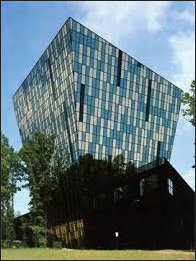by James A. Bacon
I’m so old that I remember when the Center for Innovative Technology, created to catalyze high-tech development in Virginia, was in charge of allocating state funds for university-based R&D. After commanding center stage in Virginia’s conversations about technology development during the 1990s and 2000s, CIT underwent successive downsizings to the point where it is a mere shell of its former self. Responsibility for overseeing state funding for R&D shifted to the State Council of Higher Education for Virginia (SCHEV), where it still resides.
The politics driving CIT’s dismemberment are long since forgotten. Now Governor Ralph Northam proposes to combine CIT with SCHEV’s Virginia Research Investment Committee, the Commonwealth Center for Advanced Manufacturing and the Commonwealth Cyber Initiative under the mantle of the Virginia Innovation Partnership Authority, reports the Richmond Times-Dispatch.
“What we have right now are multiple initiatives, all with good intent,” Secretary of Commerce and Trade Brian Ball said in an interview. “What we’re trying to do is pull all these together in one authority so we can allocate resources in the most efficient possible way.”
The idea of merging technology-related initiatives has gained widespread buy-in over the past year, most crucially from the Northern Virginia Technology Council, which represents the interests of Virginia’s largest, most powerful technology cluster.
The RTD describes what the Northam administration has in mind:
The new authority would be governed by a nine-member board of directors, who would be chosen because of their expertise in venture capital, technology, commercialization on intellectual property, and entrepreneurial development.
The legislation would create a new division for building entrepreneurial ecosystems, while consolidating existing state initiatives in divisions for research commercialization and investment, directly or indirectly, in new research-driven businesses, including those founded by women, minorities or people in underrepresented parts of Virginia.
The impending sale of the CIT’s iconic headquarters building near Washington Dulles International Airport is expected to generate additional funds the state can use for technology-related investments.
Bacon’s bottom line: Once upon a time, Virginia’s technology community had a powerful voice in state public policy. CIT, founded in 1985, had a significant budget, and a succession of presidents such as Bob Templin were well known in business communities around the state. The Gilmore administration created the nation’s first Secretary of Technology — a position ably filled by Don Upson — to act as a catalyst and advocate for the tech sector. The creation of regional tech councils, supported in part by CIT, sparked a wave of enthusiasm for tech-related entrepreneurial development across Virginia. Building on this foundation, Governor Mark Warner made it one of his signature economic-development initiatives to boost R&D in state universities and dismantle barriers to the local commercialization of patents emerging from Virginia institutions.
Funding for technology initiatives was gutted during the 2007-2008 recession, and never fully recovered. Northam eliminated the post of Secretary of Technology in 2018. The tech sector no longer has the voice in public policy deliberations that it once did.
The contribution of the CIT and the regional tech councils is greatly under-appreciated in the political community. Technology innovation thrives in “innovation ecosystems,” comprised of synergy-driven clusters of tech companies, university research research programs, and higher-ed pipelines delivering employees with advanced tech skills. These ecosystems require an invisible connective tissue — forums that facilitate communication and interaction among stakeholders. CIT and the Secretary of Technology both were part of that connective tissue. Warner’s secretary Aneesh Chopra, for instance, was a one-man networking phenomenon who delighted in spotting enterprises with similar capabilities and making introductions. I thought of him as a Johnnie Appleseed of Innovation, planting seeds all around the state. (He went on to become President Obama’s chief technology officer.) As the CIT and Secretary of Technology roles diminished, however, the connective tissue shrank, and so did the vitality of the tech community with it.
Hopefully, consolidating Virginia’s tech initiatives under one roof will accomplish more than the proverbial rearranging of deck chairs on the Titanic. Ideally, creating a single entity will give technology issues a higher public-policy profile, reinvigorate the connective tissue of innovation ecosystems, and breathe new life into technology-driven economic development.



